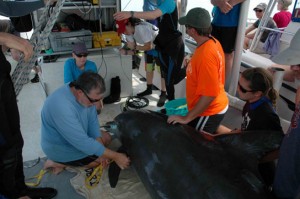Gulf Dolphins endangered by the BP Oil Spill
Tuesday, March 27th, 2012 5:10:39 by Taimoor Tariq
According to a new data from the 2011 NOAA tests, the bottlenose dolphins of the Gulf of Mexicoare underweight, anaemic and have low blood sugar and show symptoms of lung and liver disease. The research was a part of the process for studying
the effects of the Deepwater Horizon oil spill
Bottlenose dolphins from the Barataria Bay in Louisiana are showing signs of severe illness according to marine mammal biologists of NOAA.
The Barataria Bay is situated in the northern Gulf of Mexico which has received prolonged and big exposure to oil during the Deepwater Horizon oil spill.
Based on comprehensive physicals of 32 live dolphins from Barataria Bay in the summer of 2011, preliminary results show that many of the dolphins in the study are underweight, anaemic, have low blood sugar and/or some symptoms of liver and lung disease.
Nearly half also have abnormally low levels of the hormones that help with stress response, metabolism and immune function.
Researchers fear that such is the poor health of these poor creatures that they will not survive for long. One of those dolphins, which was last observed and studied in late 2011, was found dead in January 2012.
NOAA and its local, state and federal partners started the Barataria Bay dolphin study in 2011 as part of the Natural Resource Damage Assessment (NRDA), the process for studying the effects of the
Deepwater Horizon oil spill.
NOAA is sharing the preliminary results from the study so that stranding responders and veterinarians can better care for live stranded dolphins and look for similar health conditions.
More than 675 dolphins have been left stranded in the northern Gulf of Mexico since February 2010. This is a much higher rate than the usual average of 74 dolphins per year which has forced NOAA to declare an Unusual Mortality Event – UME.
Most of these stranded dolphins have been found dead and there has been a significant increase in the strandings of younger dolphins which is a cause for concern.
In the spring, it is typical to see some newborn, fetal and stillborn dolphins strand, and there has been an increase in strandings of this younger age class during this UME in 2010 and 2011. Yet all age classes continue to strand at high levels. NOAA is
working with a team of marine mammal health experts to investigate the factors that may be contributing to the dolphin mortalities.
Tags: BP Deepwater Horizon, dolphins, gujrawala, NOAA, ocean, Shahbaz Bhatti
Short URL: https://www.newspakistan.pk/?p=17320

















